Dialogue
A space that living beings can inhabit is created
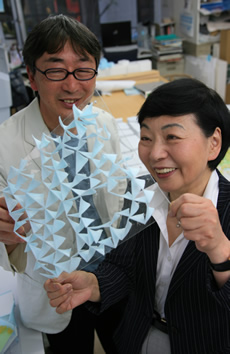
An architectural model recently submitted to a competition (the redevelopment of the Les Halles district in Paris)
Photograph by Naruaki Onishi
Nakamura :
Buildings are artificial creations, but people live inside them. That’s why I want them to have some connection with nature. What is the most important factor now for achieving that?
Ito :
The reason we haven’t been able to attain full architectural expression until now is that we replaced fluid structures in space. The emerging grid that I conceived can create a cave-like space from a surface-like grid pattern. Using a computer, we’ve been able at last to approach a system that incorporates nature to a small degree.
Nakamura :
Bees, birds, and all living creatures build nests. Since people are living creatures too, I’d prefer that the places where they live have a sense of a living creature. That’s why I’m glad they have curved lines and movement. They seem so pleasant.
Ito :
If the symbol of 20th century architecture is square, three-dimensional grids, I’d like to create spaces for people to congregate while freely developing grid-like surfaces made entirely with curved surfaces. I want everyone to consider both buildings and themselves to be one with the external environment, creating a space that links interior and exterior.
Nakamura :
That’s because nature has no straight lines. It’s interesting that you’ve used a computer to reach the point of caves and create again a sense of living in nature. They’re comfortable, and in them, I sense the potential for creating spaces that can allow human beings to recover their life force.
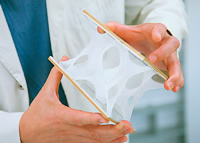
This is a model of the emerging grid. The curved surface is layered, creating a free space that continues indefinitely. “The wall surfaces resemble a cell’s double membranes.” (Nakamura)
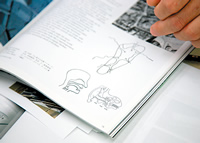
The body organs of living creatures become a model when considering the inside and the outside of buildings. Diagrams of internal organs were used as part of the materials submitted to the competition.
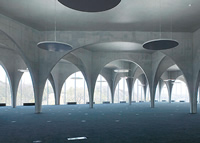
This is the Tama Art University Library. “The space created from the image of a cave dug underground is expressed in the form of an arch when it rises above the earth’s surface.” (Ito)
Courtesy: Ishiguro Photo Lab.
After the dialogue
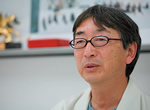
That’s why this dialogue held a strong sense of confirmation for me. Ms. Nakamura has conducted research with her subject being that which has life amidst nature. I deal with buildings, which are artificial, but our ideas are as one in regard to the ideal relationship between people and nature. That is life which includes human beings. I think it can be said that this is an Eastern concept which idealizes the coexistence of all with nature. No matter how much we talk about ecology and sustainability, conditions will not change in the slightest as long as buildings and cities are not considered to be part of nature. I have a sense that I glimpsed the essence of that idea in Ms. Nakamura’s face when she talked about her joy in growing plants in her garden.
Born in Seoul in 1941, he graduated from Department of Architecture, Faculty of Engineering, the University of Tokyo. He established Atelier in 1971. In recent years, he has been developing organic architecture using his own algorithms. His noteworthy designs include such buildings as Sendai Mediatheque and the Serpentine Gallery. His written works include Kaze no Henyotai and others.
- Dialogue:A space that living beings can inhabit is created
Toyo Ito / Keiko Nakamura - Research01:Discovering the principles by which form is created
Atsushi Mochizuki - Research02:A sensor that functions like the nose at the pole of the coliform bacillus
Ikuro Kawagishi - Scientist Library:From chromosome research to life inheritance science
Mitsuhiro Yanagida
|
|